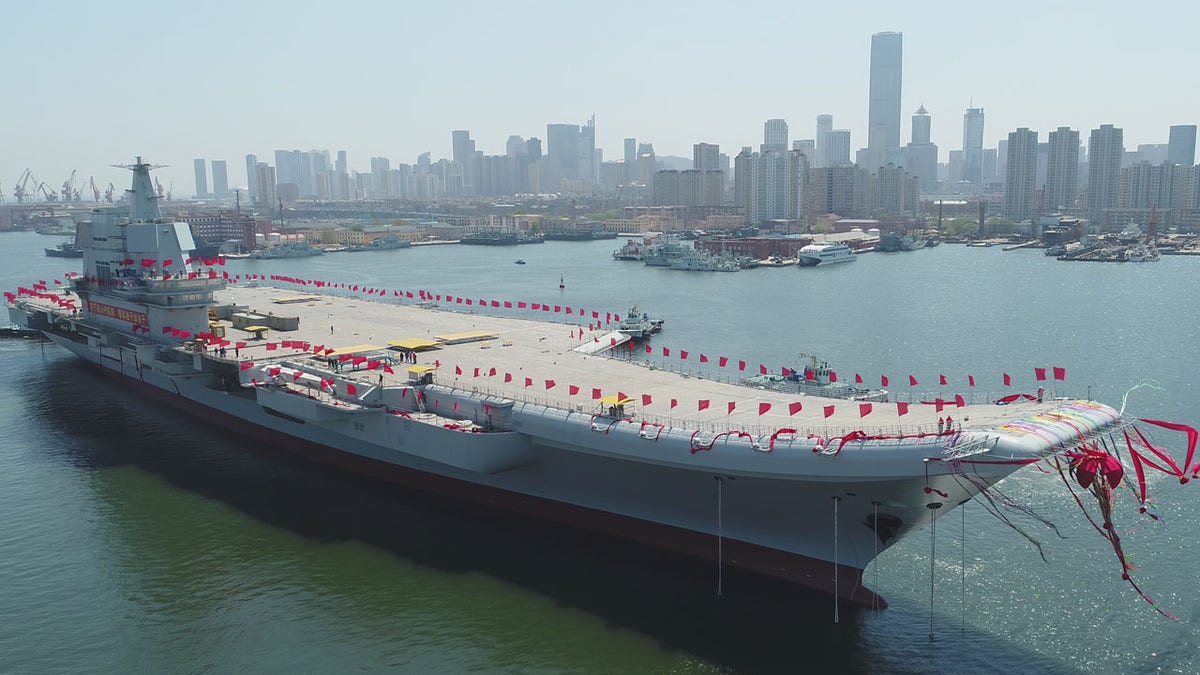China joins Russia in military exercises
Fox News’ Alex Hogan on radiation concerns in Ukraine, China joining in Russian military exercises.
For years, military analysts and policymakers have debated whether Russia or China, both of which the Pentagon has designated as near peer competitors, presents a bigger threat to the homeland. While the Trump administration’s defense policy prioritized both Russia and China as top threats, the Biden administration has designated China as its top priority, though it acknowledges that Russia poses "acute threats."
The newly updated classified National Defense Strategy, which was briefed to Congress in March, placed China first and Russia second as key U.S. defense priorities. "Defending the homeland" from the PRC threat and "deterring aggression, while being prepared to prevail in conflict when necessary, prioritizing the PRC challenge in the Indo-Pacific, then the Russia challenge in Europe," the strategy states, in order of priority.
But what the strategy is missing is that while China is indeed the long-term threat, Russia is the nation that imperils the U.S. and our allies most right now.
CHINA HAS REPEATEDLY SIMULATED ATTACKS ON US WARSHIPS, TAIWAN WARNS
Both Russia and China are of course, a danger and view the U.S. as their mortal enemy. While neither country has plans to invade the United States or to launch a "bolt-out-of-the-blue missile strike on the homeland, both have developed doctrines that seek to defeat the United States. Both adversaries have redefined the traditional battlefield of ground, air, and sea, to include space and cyberspace, and have developed formidable non-kinetic arsenals to conduct space warfare and cyber warfare against U.S. military, intelligence, and civilian networks and systems.

In this photo released by China's Xinhua News Agency, a newly-built aircraft carrier is transferred from dry dock into the water at a launch ceremony at a shipyard in Dalian in northeastern China's Liaoning Province, Wednesday, April 26, 2017. (AP)
Both countries are targeting American institutions and Americans with relentless espionage, election interference, and influence operations, sometimes getting uncomfortably close to the heart of Washington decision-making. And both have made significant advances in the development of new technologies, such as directed-energy weapons, electromagnetic pulse weapons, smart bombs, anti-radar systems, electronic warfare, anti-satellite weapons, and undersea warfare capabilities. But one is a nearer-term threat than the other.
Also in March, as the administration was rolling out its China-first strategy, Air Force Gen. Glen D. VanHerck, the head of U.S. Northern Command and North American Aerospace Command, (NORAD) and in charge of protecting the homeland and Canada from missile strikes, identified Russia as the "primary military threat to the homeland." He highlighted that over the last 15 years, Russia has "developed offensive capabilities below the nuclear threshold" to constrain U.S. options in an escalating crisis.
The general echoed his own assessment from last year, when he identified Russia as "the most acute challenge" to defending the U.S. "It is not China — it is Russia," VanHerck said at an unclassified conference last year. "From a kinetic standpoint — submarines, bombers, cruise missiles, those kinds of capabilities — Russia is the primary military threat," he said, warning that it is that it is how they "rehearse potential strikes on our homeland."
On Saturday, the head of U.S. Strategic Command, whose mission is to protect the homeland and our allies from nuclear strikes, Navy Admiral Charles "Chas" A. Richard, noted that "Both Russia and China have the ability to unilaterally at their own choosing, go to any level of violence, to go to any domain to go worldwide, with all instruments of national power." He added that if Moscow and Beijing worked in tandem it would compound the threat.
While Russia and China both have formidable militaries, Russia’s is an existential threat to America, as it is the only country in the world that has the capability to destroy the homeland in a strategic nuclear strike. China has no such capability. Russia also has extensive and recent combat experience, having conducted military campaigns in Chechnya in the 1990s, Georgia in 2008, Crimea in 2014, and Syria in 2015, where the Russian forces are still engaged.
Moscow is also more aggressive in using military interventions to attain its goals, while China so far has given preference to non-combat operations while signaling its willingness to ratchet up hostilities. Faced with immediate demographic and economic challenges, Russia feels the pressure to attain its strategic ambitions in the short-term, while China has taken a long-term approach. Russian President Vladimir Putin has already begun the kinetic phase of his master plan to re-establish control over former Soviet nations like Ukraine, while Chinese President Xi Jinping seeks to eventually re-subjugate Taiwan.
CLICK HERE TO GET THE OPINION NEWSLETTER
The Ukrainian war amplifies the immediate threat from Russia. In the view of the Kremlin, Russia and the United States are in the middle of what Moscow views as a proxy war over control of Ukraine. That is, Moscow in a sense sees the U.S. and Russia at war right now. Given this, and with U.S.-Russia relations having deteriorated to what appears as the point of no return, the risk of escalation of hostilities into a direct military confrontation between two nuclear superpowers is powerful. Russia has developed a sophisticated nuclear doctrine, which envisions a detonation of a low-yield tactical nuclear warhead in the theater of combat operations, such as in Ukraine, as a way of compelling the United States and NATO not to intervene. The fallout from such an event — both literally and in terms of the US-Russia confrontation — is unpredictable.
Putin perceives the United States as openly trying to end his rule. Several U.S. officials have all but called for Putin’s regime change. Secretary of Defense Lloyd Austin has admitted that Washington seeks to degrade Russia’s military and weaken its economy. Biden himself called Putin a war criminal. For Putin and his allies who are in charge in the Kremlin, the struggle in Ukraine is existential, both for them and for Russia, and the risk is that he will resort to extreme measures to achieve victory there is great.
CLICK HERE TO GET THE FOX NEWS APP
This is why Russia is a much bigger threat, no matter what the Biden administration and the Washington groupthink may believe. Beijing has a much more comprehensive long-term threatening designs on America, seeking to supplant the U.S. by 2049 as both military and economic power, with the Chinese Yuan replacing the dollar as the premier international reserve currency. But that’s for 2049. The Russian menace is dated 2022.


